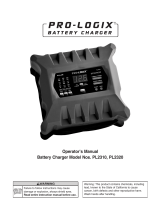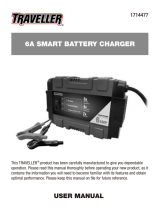
WARNING
NEVER alter AC cord or plug. If it will not fit, have a proper outlet installed by a qualified electrician. Improper
connection may result in an electric shock.
Note: Useof an adapter is not allowed in Canada.If a grounding type receptacle is not available, do not use
this appliance until the proper outlet has been installed by a qualified electrician.
AD~J
GROUNDING
MEANS
Figure
18
I
GROUNDING
PIN (A)
Figure
1A
Preparing to Charge
1. Ensure battery to be charged is 12 volt nominal lead acid type.
2. If it is necessary to remove battery from vehicle to charge, or to clean terminals, always remove grounded terminal
from battery first. Make sure all accessories in the vehicle are off, so as not to cause an arc.
3. Clean battery terminals. Do not allow corrosion to come in contact with eyes.
4. Add distilled water in each cell until battery acid reaches level specified by battery manufacturer. This helps purge
excessive gas from cells. Do not overfill. For a battery without cell caps (maintenance free), carefully follow
manufacturer's charging instructions.
5. Study all battery manufacturer's specific precautions, such as removing or not removing cell caps while charging, and
recommended rates of charge.
6. Area around battery should be well ventilated while battery is being charged. Gas can be forcefully blown away by
using a piece of cardboard or other nonmetallic material as a fan.
7. Make sure the initial charging rate does not exceed battery manufacturer's requirement.
Charger Location
1. Locate charger as far away from battery as cables permit.
2. NEVERplace charger directly above battery being charged; gases from battery will corrode and damage charger.
3. NEVERallow battery acid to drip on charger when reading gravity or filling battery.
4. NEVERoperate charger in a closed-in area or restrict ventilation in any way.
5. Marine batteries must be removed and charged onshore.
6. Do not set a battery on top of charger.
DC Connection Precautions
1. Connect and disconnect DC output clamps only after removing AC cord from electric outlet.
2. Never allow clamps to touch each other.
3. Attach clamps to battery chassis as indicated in "Battery Installed in Vehicle" steps 5 and 6, and in "Battery Outside
of Vehicle" steps 2, 4 and 5. This charger is not designed for marine onboard charging applications.
If a properly grounded outlet is not available, a temporary adapter (like the adapter shown in Figure1 B) may be used to
connect this plug to a two-pole receptacle. The temporary adapter should be used ONLY until a properly grounded outlet
can be installed by a qualified electrician.
DANGER- Before using an adapter as illustrated, make certain that the center screw of outlet plate is grounded.
The green-colored rigid ear or tab extending from adapter must be connected to a properly grounded outlet. MAKE CERTAIN
IT IS GROUNDED.If necessary, replace original outlet cover plate screw with a longer screw that will secure adapter ground
tab to outlet cover plate and connect to grounded outlet.
IMPORTANT SAFETY INSTRUCTIONS
Personal Safety
1. Another person should be within range of your voice or close enough to come to your aid when you work near a lead-
acid battery ..
2. Fresh water and soap should be nearby in case battery acid contacts skin, clothing, or eyes.
3. Wear complete eye protection and clothing protection. Avoid touching eyes while working with a battery. Acid, acid
particles or corrosion may get into eyes. Immediately flood eye with cold water (Eye Wash Station) for at least 15
minutes and seek medical attention immediately.
4. If battery acid contacts skin or clothing, wash immediately with soap and water. If redness, pain or irritation occurs,
seek immediate medical attention.
5. NEVERsmoke or allow a spark or flame in vicinity of battery or engine.
6. Be extra cautious to reduce the risk of dropping a metal tool onto battery. This might cause sparks or short-circuit
the battery or other electrical part, which can cause an explosion.
7. Remove personal metal items such as rings, bracelets, necklaces and watches when working with a lead-acid
battery. A lead-acid battery can produce a short-circuit current high enough to cause a severe burn.
8. Use charger for charging a LEAD-ACID battery only. It is not intended to supply power to a low-voltage electrical
system other than in a starter-motor application. Do not use the battery charger for charging dry-cell batteries that
are commonly used with home appliances. These batteries may burst and cause injury to persons and damage
property.
9. NEVERATTEMPTTO CHARGEA FROZENBATTERY.
Power Cord Safety
Charger should be grounded to reduce risk of electric shock. Charger is equipped with an AC cord having equipment-
grounding conductor and a grounding plug. The plug must be plugged into a properly installed and grounded 110/120 volt AC
outlet in accordance with all local codes and ordinances (see Figure 1A).
Battery Safety
1. Use of an attachment not recommended or sold by the battery charger manufacturer may result in a risk of fire,
electric S110ck,or injury to persons.
2. To reduce risk of damage to electric plug and cord, pull by plug rather than cord when disconnecting charger.
3. An extension cord should not be used unless absolutely necessary. Use of an improper extension cord could result
in a risk of fire and electric shock, and will void warranty.
If an extension cord must be used, make sure:
a. tl1at pins on plug of extension cord are the same number, size, and shape as those of plug on charger;
b. that extension cord is properly wired and in good electrical condition; and
c. that wire size is AWG#14 (14 gauge) for 100 feet and AWG#12 for distances over 100 feet.
4. Do not operate charger with damaged cord or plug - take to a qualified technician for replacement of the plug or
cord immediately.
5. Do not operate charger if it has received a sharp blow, been dropped, or otherwise damaged in any way. Call
Technical Support toll-free at (800) 618-5178.
6. Do not disassemble charger; take it to a qualified service technician when service or repair is required. Incorrect
reassembly may result in a risk of electric shock or fire, and will void warranty.
7. To reduce risk of electric shock, unplug charger from outlet before attempting any maintenance or cleaning. Turning
off controls without unplugging will not reduce this risk.
8. Do not expose charger to rain, snow or use when wet.
WARNINGS
1. RISK OF EXPLOSIVE GAS MIXTURES - WORKING IN VICINITY OF A LEAD-ACID BATTERY IS DANGEROUS.
BATTERIES GENERATE EXPLOSIVE GASES DURING NORMAL BATTERY OPERATION. FORTHIS REASON, IT IS OF
UTMOST IMPORTANCE THAT EACH TIME BEFORE USING YOUR CHARGER, YOU READ THIS MANUAL AND
FOLLOW THE INSTRUCTIONS EXACTLY.
2. To reduce risk of battery explosion, follow these instructions and those published by the battery manufacturer
and manufacturer of any equipment you intend to use in vicinity of battery. Review cautionary marl;ings on
these products and on engine.
3. This equipment employs parts (switches, relays, etc.) that produce arcs or sparks. Therefore, if used in a
garage or enclosed area, the unit MUST be placed not less than 18 inches above the floor.








